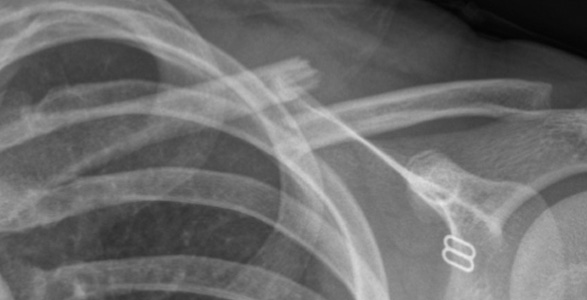Clavicle Fracture
An Overview
What is a clavicle fracture?
The clavicle, often called the collarbone, is a bone connecting your chestbone (sternum) to your shoulder blade. It’s one of the most commonly broken bones in the body.
Symptoms
- Severe pain and swelling at the fracture site
- Difficulty moving or limited movement in your shoulder
- Visible deformity or a bump over the break, in some cases
- Bruising around the area
Diagnosis
- Physical examination by a doctor to assess the injury
- X-rays to confirm the fracture location and severity
Treatment
Most clavicle fractures heal well without surgery. This typically involves:
- Immobilization: Wearing a sling for 6 weeks to support the bone while it heals.
- Pain medication: To manage discomfort during the healing process.
- Physical therapy: Exercises to regain full range of motion and strength in your shoulder.
Surgery
Surgery may be needed in some cases, such as:
- When the broken bone fragments are significantly displaced.
- When the fracture disrupts the nearby joints.
Types of Surgery
- Plates and screws: These implants hold the bone fragments together during healing.
- Intramedullary nail: A single nail is inserted inside the bone to stabilize the fracture. This option may offer a smaller incision and faster recovery in certain cases.
Radiographs showing fixation of the clavicle with an intramedullary device.
Recovery
- Pain management: You’ll receive pain medication to control discomfort after surgery.
- Wound care: It’s crucial to keep the surgical wound clean and dry for about 2 weeks.
- Sling: You’ll likely wear a sling for 6 weeks to support the healing bone.
- Physical therapy: Exercises will help regain full range of motion and strength in your shoulder.
- Total healing: It takes 3-4 months for complete bone healing.
- Hardware removal: In rare cases, a second surgery might be needed to remove plates or screws if they become prominent or cause discomfort.
Risks and complications
Although uncommon, potential risks associated with surgery include:
- Infection
- Nerve or blood vessel damage
- Prolonged healing requiring hardware removal
Radiographs showing fixation of the clavicle with Plate and Screws
Overall, clavicle fracture surgery is considered safe with a low complication rate.
Important Note:
This information is intended for general knowledge only and should not be taken as medical advice. Always consult with a qualified healthcare professional for diagnosis and treatment specific to your situation.





